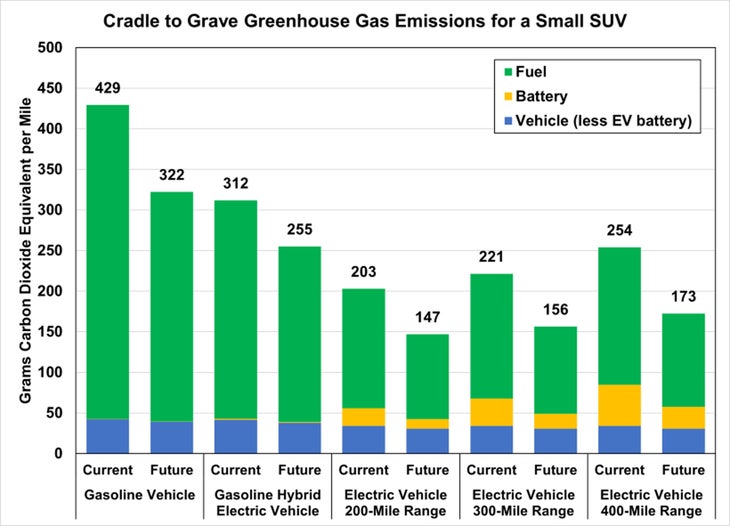I have a friend, Jon, who’s been driving his cherry-red Volkswagen Jetta for more than two decades. The odometer reads 170,000 miles.
Jon is a committed environmentalist. He rides his bike almost everywhere and only rolls his Jetta, which gets about 40 miles per gallon, out of the driveway when he’s stocking up on groceries or taking a trip to the mountains.

Jon is toying with the idea of retiring his trusty combustion engine and buying a new or used electric car. But he’s been wondering if the more environmentally-conscious choice is to simply drive his old car until it falls apart. Is keeping his old car running greener than buying a new electric car?
It’s a fair question, because the golden rule of sustainability is to curb consumption and only buy what you need. Jon doesn’t need a new car. He barely drives the one he has, bless his Lycra- and helmet-clad soul. Jon’s mechanic says the Jetta will keep chugging along for another 200,000 miles (or, at his driving rate, another 40 years) with proper maintenance.
Jon wants to do right by the planet and support the transition to clean energy. And he’s fortunate enough to have the means to buy a new electric car. But should he?
Not right away, says Dan Gearino, a clean energy expert at Inside Climate News, a nonprofit news organization focusing on climate journalism.
“Take a few steps back and consider: how bad is your current vehicle?” asks Gearino. “If your car gets great fuel economy and you don’t drive a lot, stick with it for a few more years. Part of that is that EVs are getting a lot better, with more range. But if you have an absolute gas guzzler and you’re driving 25K miles per year, switching to an EV now makes sense.”
Admittedly, Jon, who cycles as many miles as he drives, is an outlier. The average American drives about 13,000 miles per year. That distance in a typical gas-powered car generates 5.2 metric tons of carbon emissions.

“In terms of things the average person can do to reduce their carbon footprint, getting rid of your vehicle altogether or switching to an EV blows everything out of the water,” says Gearino. “It’s just huge in terms of helping to develop the EV market, which is a vital step toward cutting into what’s the largest source of emissions in U.S.—transportation.”
Have you been mulling over whether to go electric or keep using what you have? Let’s tackle some of the key questions that might help you make your decision.
Does the Manufacturing Impact of Electric Cars Outweigh the Benefits?
You might have read that the manufacturing footprint of EVs–in particular their huge batteries–is actually than that of traditional cars. While true, the overall impact on the environment doesn’t start and end with a car’s construction. When comparing the footprint of cars, you have to think about it from cradle to grave, says Jarod Kelly, a vehicle systems analyst engineer at Argonne National Library who studies the environmental impact of past and future vehicle technologies.

“While electric cars use more energy and resources to build than combustion engine cars, once you start driving, the carbon footprint gap immediately starts to narrow,” says Kelly. “There quickly comes a tipping point in the life of an electric car where the emissions savings pays off the manufacturing footprint.” That typically happens at around .
Another environmental headache of EVs: the intense and invasive mining for rare minerals (lithium and cobalt, among others) required to make the batteries. Procuring these critical elements from the earth : excessive groundwater use, environmental pollution caused by toxic tailings, and other unfortunate side effects like potential in certain areas.
“As with most manufacturing, there are impacts associated with extraction of raw materials,” says David Reichmuth, senior engineer in the clean transportation program at the . “Minerals used to build batteries must be mined as sustainably as possible, with ample community buy-in every step of the way. If mining is done, it must be done right.”
Reichmuth predicts that we will soon see technology advances and new materials for batteries and that pushing forward on multiple fronts is key. “This includes ensuring that equitable practices are in place to reduce mining impacts, that batteries are recycled at their end of life, and that increased modes of alternative transportation are available,” he says.
Can I Afford an Electric Car?
With any big purchase, your finances play a major role in the decision-making process. You might think an EV is out of your price range. But the landscape has changed recently: price drops, incentives, and a growing used market.
According to , the average transaction price for new electric cars was $5,135 higher than for gas-powered vehicles in July 2023, and experts predict that the pricing gap will continue to shrink. (The most new affordable EV on the market these days is the Chevy Bolt, with a sticker price of $27,495.)
A slew of state and federal incentives also make the switch sweeter (thank you Inflation Reduction Act). You can get up to a $7,500 in federal tax credit for buying or leasing a new electric car and up to $4,000 for a used one (the exact amount will depend on a variety of factors including your income and the model you choose). State rebates and incentives vary, but are often significant to close that price gap. For example, Massachusetts will rebate up to $5,000 for an EV purchase and up to $2,700 for installing a home charger.
Some states will even pay you more to retire your old clunker and switch to an electric car, says Reichmuth. California’s program is aimed at lower income families who want to make the switch and offers incentives up to $9,500. In Colorado, the helps income-qualified residents switch to EVs and retire and recycle their old emission spewers with incentives up to $6,000.
Check out Consumer Reports’ for navigating the incentives specific to your area.
The other thing to remember, says Reichmuth, is that more used EVs are coming onto the market every day. Used EV sales are expected to top 1 million cars in 2023. Because of this, the average price of used electric cars is dropping—down 28 percent in the last year. According to , 40 percent of all used EV inventory is priced at $30K or below.
And if you’re worried maintenance costs will go up if you switch to an electric car? Don’t. EVs are about than gas cars to maintain over their lifetime.
Will an Electric Car Match My Outdoor Lifestyle?
Short answer: hell yes. In our recent review of the best outdoorsy adventure vehicles coming out in 2023, four of eight are electric. One car to make our list is the Subaru Solterra, a compact SUV with all-wheel drive and 8.3 inches of clearance. And if a classic pickup truck is more your thing, there’s the Chevy Silverado EV which can haul up to 1,400 pounds and tow 10,000.
But Reichmuth says we should prioritize our needs—not our wants—when purchasing an EV. If a small or midsize SUV will get the job done, resist the urge to indulge in the extra space. If you only drive on pavement and don’t need hauling or towing power, don’t buy a truck.
“If we want to avoid the impacts of climate change, we need cleaner vehicles and a cleaner energy grid from which to charge them,” says Reichmuth. “We don’t have time to wait for a perfectly clean grid, then all switch to EVs. We can’t move fast enough on this.”

Doing right by the planet can make you happier, healthier, and—yes—wealthier. �����ԹϺ���’s Head of Sustainability, Kristin Hostetter, explores small lifestyle tweaks that can make a big impact. Write to her at climateneutral-ish@outsideinc.com.


